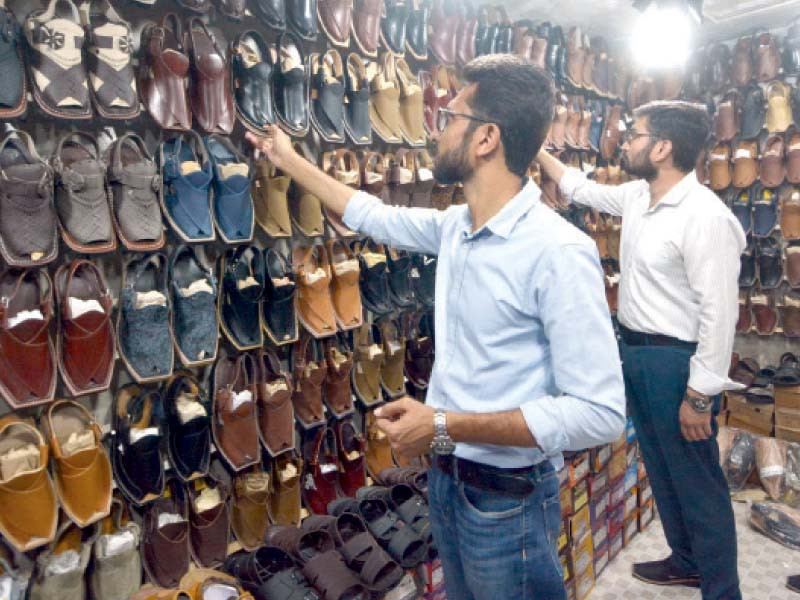
At the popular chappal market in Nazimabad, shopkeepers and buyers are busy haggling over prices of Peshawari chappals. With Eidul Fitr around the corner, there has been a surge in demand for Peshawari chappals, the preferred footwear among men at the annual religious celebration.
A mid-tier employee at a private firm, Adil had to tread carefully all year due to the country's collapsing economy. On Eid day, though, he wants to strut his wares. "I like shiny, glistening dark Peshawari chappals under my white kurta shalwar on Eid day," he asserted.
Peshawari chappals are also known for their comfort and durability, with constant new designs as well as references to the country's political situation.
One such innovation was the Kaptaan Chappal, named after PTI leader Imran Khan who is referred to as kaptaan.
"With Imran Khan's popularity graph going up, Kaptan Chappal was the most popular among Peshawari chappals for the last four years. But since last year, the Zardari Chappal design has also gained in popularity," said Sami Ullah, a shopkeeper at the Nazimabad market.
The story goes that a popular shoemaker in Peshawar made a special chappal for Asif Ali Zardari, a former president and widely believed to be one of the kingmakers of Pakistani politics. The chappal gained quite a bit of popularity among supporters of Zardari's party.
"Kaptaan Chappals are made of hard leather, while Zardari chappals are soft and flexible. They are equally good in terms of strength," he said.
"Zardari chappals are cheaper than thick-soled layered Kaptan Chappals," he said to explain the price difference. Both styles became popular in the markets of Peshawar and Charsadda. Sami added that Zardari chappals have stripes and some stylistic additions including embroidery.
Other new designs have also emerged with names such as Markhor, Peshawar Zalmi, Vikram Sol, Kohati and Bannu. This is in additional to older styles like the zari style of Mianwali, which has embroidery, and chappals originating from other regions.
Apart from these, Kohati, Chakwali, Multani, Lahori and Balochi chappals are also popular.
The effects of inflation are also noticeable on Peshawar chappals. The price has increased by Rs300 rupees compared to last year. On average, these chappals are sold for Rs 1,200 to 1,500.
The branded ones sell for a little higher, and can range from anywhere between Rs2,000 to Rs5,000.
The demand for such chappals has increased significantly since last year," said Sami, the shopkeeper in Nazimabad.
Kaptan chappals were being sold between Rs5,000 to Rs8,000 while the price of Zardari chappals was between Rs2500 to Rs3,0000.
Another popular style is Balochi chappals, available around the city and at a market in Lyari. It can range from anywhere from Rs5,000 to Rs25,000 depending upon requirements.
Where to go
The biggest and oldest market of Peshawari chappal in the city is located at Nazimabad Number 2.
It offers a wide variety and style of chappals with a high amount of price variability. Most of the chapplas are manufactured in workshops and units set up near the market. Smaller markets for Peshawari chappals can be found across the city including in Benaras, Kemari, Lasbela, Old Subzi Mandi among others.
A large number of these slippers come from Bannu and Charsadda in Khyber-Pakhtunkhwa. Charsadda is also home to the most popular Peshawari chappal market in the country.
The chappal makers of K-P say they have made more varieties of chappals than any other footwear in the world.
Around 200 types and designs of chappals are hand made, including the F-16 three-gauge Charsada chappals, Kohati chappals, Sheepskin Norez Balochi chappal, Mardan chappal, and various types of leather chappals. Apart from this, there are more than 50 types of slippers of Multan and Lahori Khussa such as nagri and kolapuri and different types of cut shoes.
Limited gains
Shopkeepers say the margins are very low as the chappals are hand stitching increases costs. Workers are paid for every pair and also provided raw material. This has cut into their profits while shopkeepers remain worried that increasing price might drive away consumers.
There is also concern that there aren't enough skilled chappal makers in Karachi. Most chappal makers bring workers from Khyber Pakhtunkhwa for Eid to deal with the increase in demand.
Workshops have been set up in Liaquatabad, New Karachi, Korangi and other suburbs, saying one shopkeeper. Workers take up to 30 per cent of the original price of the chappal, they said. A craftsman can prepare one to two pair of standard and durable chapplas in a day while normal worker can prepare eight to ten pairs of normal shoes.
Published in The Express Tribune, April 18th, 2023.



1725453065-0/Untitled-design-(12)1725453065-0-165x106.webp)


1727424398-0/Copy-of-Untitled-(32)1727424398-0-270x192.webp)

1727415147-0/Untitled-design-(43)1727415147-0-270x192.webp)









COMMENTS
Comments are moderated and generally will be posted if they are on-topic and not abusive.
For more information, please see our Comments FAQ